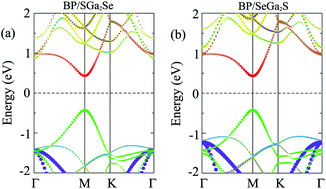Electronic structure and interface contact of two-dimensional van der Waals boron phosphide/Ga2SSe heterostructures†
Abstract
In this work, we systematically examine the electronic features and contact types of van der Waals heterostructures (vdWHs) combining single-layer boron phosphide (BP) and Janus Ga2SSe using first-principles calculations. Owing to the out-of-plane symmetry being broken, the BP/Ga2SSe vdWHs are divided into two different stacking patterns, which are BP/SGa2Se and BP/SeGa2S. Our results demonstrate that these stacking patterns are structurally and mechanically stable. The combination of single-layer BP and Janus Ga2SSe gives rise to an enhancement in the Young’s modulus compared to the constituent monolayers. Furthermore, at the ground state, the BP/Ga2SSe vdWHs possess a type-I (straddling) band alignment, which is desired for next-generation optoelectronic applications. The interlayer separation and electric field are effectively used to tune the electronic features of the BP/Ga2SSe vdWH from the type-I to type-II band alignment, and from semiconductor to metal. Our findings show that the BP/Ga2SSe vdWH would be appropriate for next-generation multifunctional optoelectronic and photovoltaic devices.



 Please wait while we load your content...
Please wait while we load your content...